1954 Spanish Grand Prix race report: Hawthorn class of the field
Mike Hawthorn wins in new modified Ferrari, Luigi Musso second for Maserati whilst Juan Manuel Fangio comes home third for Mercedes

Motorsport Images
Barcelona, October 24th.
After being abandoned for the past two years the Spanish Grand Prix was held this year and was the last round in the 1954 World Championship series. With the Grand Prix teams getting more and more into their stride throughout the season the Pena Rhin club benefited from this and had a remarkably strong entry for their event to close the 1954 season. The greatest interest was undoubtedly the presence of the new Lancia team and just as Mercédès-Benz dominated the practice periods for the French Grand Prix, back in July, being new and interesting cars that were proving very fast, so the practice for the Barcelona race was dominated by the Lancia team, equally new and equally interesting.
Held in the late afternoon on the Thursday and Friday before the race the first practice period saw Ascari and Villoresi, with the new Lancia V8 Grand Prix cars, surprising everyone with their speed. The Pedralbes circuit on which the Grand Prix has been run since 1946 is a fast one, but at the same time has some difficult and bumpy corners so that driving and the qualities of the car count for everything. Lancia arrived with three cars in their huge Lancia diesel transporter and an Aprilia van in attendance to carry the toolboxes, while their drivers were Ascari and Villoresi, the third car being used by both of them for practice as well as their race cars.
These new cars from Turin were extremely small and squat, with their fuel tanks on outriggers alongside the body, the 4 ohc V8 engine set at an angle in the frame, the hydraulically-operated clutch, gearbox and final drive in one unit at the rear, and great detail attention having been paid to weight-saving. The suggested four-wheel drive theory expounded in Motor Sport last month proved to be entirely false, there being no sign of such a layout nor any possibility of there ever having been such a system of transmission. A full description of these cars with illustrations will appear in the December issue of Motor Sport.
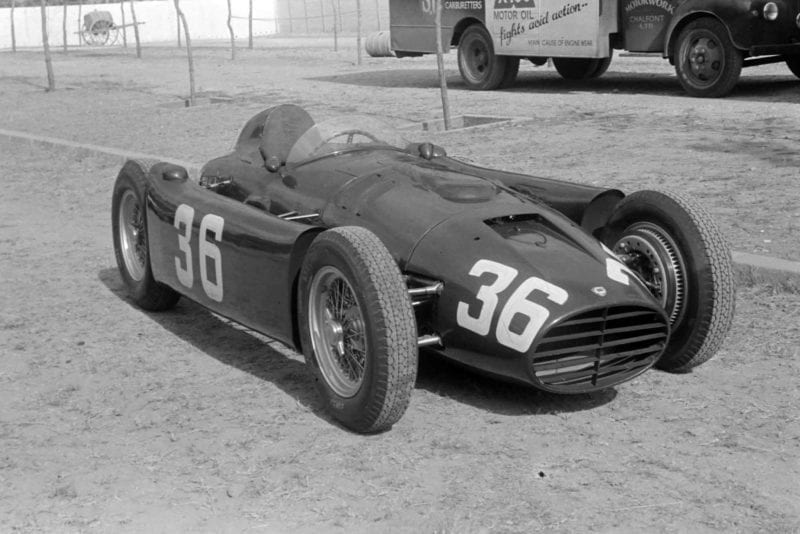
Villoresi’s Lancia D50 awaits the on-track action
Motorsport Images
In opposition were three Mercédès-Benz cars, two the exposed-wheel type and one a streamlined model, the all-enveloping one still having the front inboard brakes coupled by a limited slip device. There was no obvious sign of any of the Stuttgart cars having been altered in any way from the cars that appeared at Monza, though the anchorages for the rear radius arms had been strengthened, and the drivers were the same three, Fangio, Kling and Herrmann.
The Ferrari team were not in a very happy state, having only two drivers available, Hawthorn and Trintignant, for Farina was still in hospital and Gonzalez was not fully recovered from the arm injury he received at Dundrod. Since Monza the Maranello firm had been doing some intensive experimenting and testing and Hawthorn had a modified version of the “stumpy” 553 model. This had coil springs for the front suspension in place of the usual transverse leaf-spring and rubber block, and in fact was the first Ferrari to be fitted with coil-spring suspension. The wishbone layout was unaltered, but an anti-roll bar had been fitted running under the front of the car.
Also in search of improved roadholding and handling the de Dion rear end had been the subject of much research and though no visible changes had been made little things had been modified and the result had been an improvement of 3 sec round Monza. Trintignant was driving one of the earlier cars fitted with an engine from a 553 model, which is to say it had the water pump mounted above the horizontal magnetos in front of the engine.
The Maserati team were out in full force with their de Dion cars, the drivers being Moss, Musso, Mantovani, Mieres and Schell, while the new car that appeared at the Paris Salon was spare, Schell driving one of the earlier ones. Finally there was the Gordini team, there being only two cars driven by Behra and Pollet; the former was making yet another “last appearance” for Gordini and was driving the 1955 car that was at the Paris Salon but it was fitted with the normal six-cylinder engine, the new one with the separate camboxes not being ready, while the latter driver had the normal 1954 Gordini with 2LS brakes.
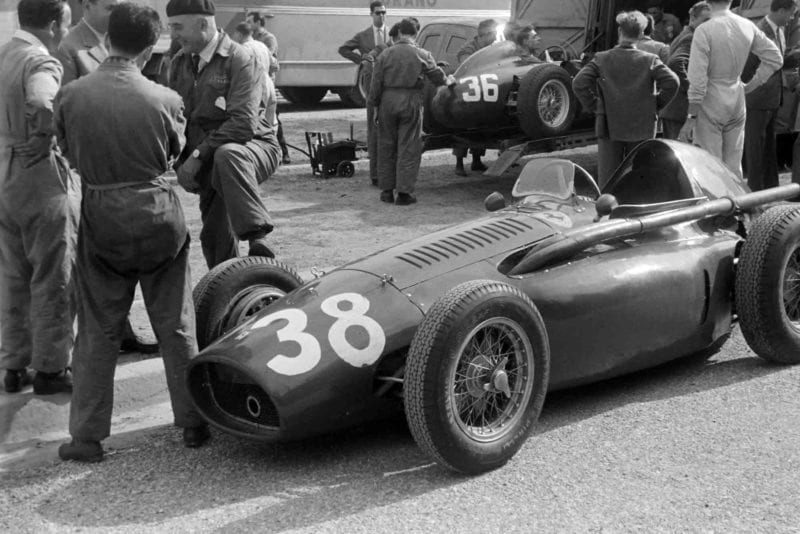
Hawthorn’s new Ferrari 553 Squalo sits outside the pits. Villoresi’s Lancia is unloaded behind
Motorsport Images
To make up the entry were a sprinkling of private runners; Bira and Rosier having their de Dion Maseratis, Wharton the Owen-modified car, de Graffenried was driving his 1953/54 Maserati, while the Spanish driver Godia was practising on the spare works Maserati. Swaters was driving the Ecurie Francorchamps Ferrari, still with the new engine with 100 deg. valve layout and Manzon was driving Rosier’s blue Ferrari four-cylinder fitted with his own engine. To complete the list was Collins with the Vanwall, as raced at Aintree and Goodwood and having its first outing in a Grand Prix in 2 ½- litre form.
Qualifying
Ascari proved easily the fastest during the first practice with a lap in 2 min 18.1 sec, though this was nearly 2 sec down on the absolute record for the course set up by Fangio with a 159 Alfa-Romeo in 1951. Villoresi was second fastest and then came Moss driving the latest works car as his own was not ready. This car had a smooth body devoid of louvres, with two large openings in each side of the car to let under-bonnet air out. Before the end of practice he, Collins and Hawthorn all blotted their copybooks, for they all spun off the road, oddly enough on the same corner.
“Before the end of practice Moss, Collins and Hawthorn all blotted their copybooks, for they all spun off the road, oddly enough on the same corner”
Moss was in the process of sorting out a spin when he trod on the throttle instead of the brake as the works car had the pedals the opposite way round to his own car, while Collins turned the Vanwall right upside down. The Maserati was only dented in the nose, but the Vanwall was badly damaged about the back-end and had to be withdrawn, which was most disheartening for the Vandervell team as they had hoped to learn much from this race which would give them something to work on during the winter; Collins himself was quite undamaged, as was Moss. Just to complete an English trio of “bad boys,” Hawthorn spun the new Ferrari and crumpled the tail but with no serious effects. Fangio was the only hope for Mercédès-Benz, driving the streamlined car, but could do no better than fourth fastest, while the two German drivers were down in the middle of the list.
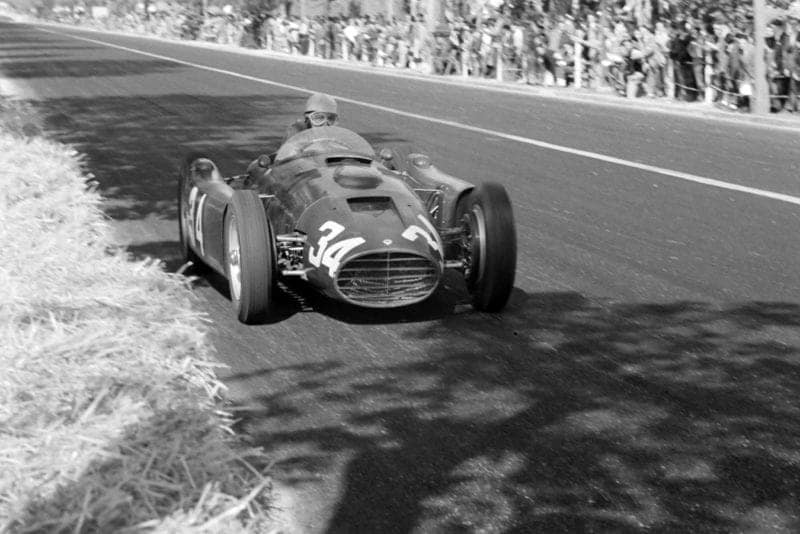
Ascari dominated qualifying in his Lancia
Motorsport Images
Friday’s practice again saw Ascari dominating the scene with the new Lancia, though Fangio in the open Mercédès-Benz began to get into his stride and he got within 0.6 sec of his chief adversary on this day. These two were the only ones to get below 2 min 20 sec, Ascari recording 2 min 18.5 sec and Fangio 2 min 19.1 sec. Hawthorn was going well in the new Ferrari, making up for his previous mistake and he recorded 2 min 20.6 sec, and this was equalled by Schell and they were followed by Musso, Villoresi, Moss, Herrmann, Mantovani and Trintignant in that order, their times being covered by 1 sec. The Lancia team seemed very happy and gave the appearance that they were doing some long-distance testing on the spare car for both drivers thrashed it round for lap after lap, occasionally doing laps on their own cars to record official times, and at no time did any of the three cars appear to give any bother.
Mercédès-Benz were continually juggling with race numbers, the drivers all trying all the cars, unable to come to any decision about streamlining, while there were so many red Maseratis about the pit area that it was difficult to keep track of which was which. Moss was not at all happy with the lap times he was making and consequently tried all the works Maseratis, but with no improvement, though Schell was going well he did not lend his car to Moss. With only two runners the Ferrari team were at a bit of loss to find anything to do, though Hawthorn’s car needed a little work done on it. When practice finished the factory teams were by no means organised and everyone went away that evening to try and convince themselves that the times recorded in practice were not really genuine; all, that is, except the Lancia team who returned to their garage, at the Pegaso service station, to prepare for their first full length motor-race with a Grand Prix car.
There was more than enough time for the various teams to have a real go at sorting things out for on the Saturday a sports-car race took place over the same 6.316 kilometre circuit, for a distance of 40 laps. This event was for International sports cars, which produced a good free-for-all in the ideas of sports cars and twenty-three cars lined up on Saturday afternoon. The race was entitled the First Premio Pena Rhin for Sports Cars and attracted a truly International entry, there being two Ecurie Ecosse Jaguars, driven by Salvadori and Sanderson, the Whitehead brothers, Peter with his fierce-looking Cooper-Jaguar and Graham with his DB3S Aston Martin, and Beauman with Sir Jeremy ‘Boles’ blue DB3 Aston Martin from Great Britain: Picard with a Ferrari Monza 750S, Rosier with his old Formula 1 Ferrari 4 ½-litre converted into a “single-seater” all-enveloping sports car, Behra with the single-seater sports Gordini 3-litre, Estager driving Rosier’s Le Mans Talbot, Michy driving Estager’s Maserati A6GCS, from France, Claes with an early 2-litre Ferrari and Arnoldt with the Ecurie Francorchamp Jaguar XK 120C with disc brakes, representing Belgium.
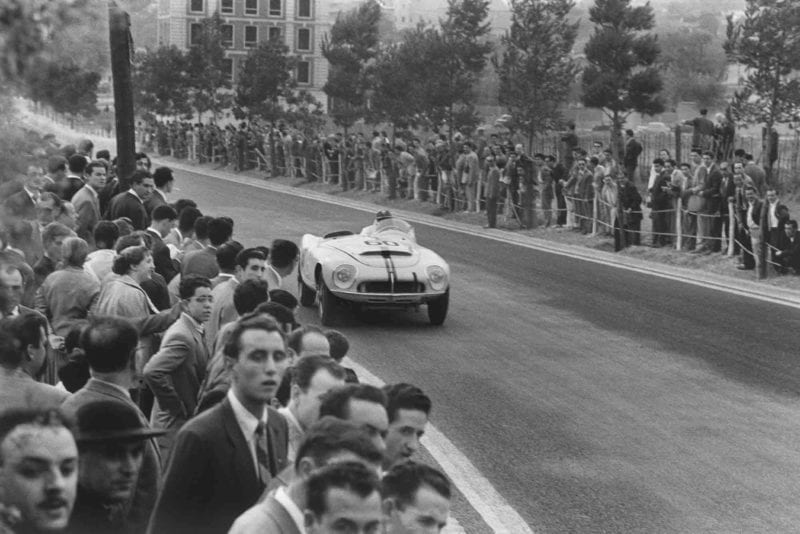
Local entrant Celso Fernandez threads through the crowds during he supporting sports car race
Motorsport Images
From Switzerland was a strong contingent led by Musy (Maserati A6GCS) and Ducrey (Alfa-Romeo 2-litre) supported by Jenny and Jonneret with Jaguars, and Felman with a Lancia G.T. Local opposition came from three Pegasos fitted with supercharger, and two of them modelled on the Mondial Ferrari as far as the body lines went. Mascarebas with a Ferrari and the Portuguese drivers Nogueira and Sameiro with Ferraris, the former with a 12-cylinder and the latter with a four-cylinder, both being 3-litres in old-type chassis.
Weather conditions were ideal as the field got away front a normal clutch start, with Behra, P. N. Whitehead, Salvadori and Rosier in the front row, positioned in order of practice times, but at the end of the opening lap it was Sanderson who led, followed by his team-mate and Behra with the Spanish driver Villamill hard on their heels with the noisy Pegaso. Of the three Pegaso drivers he was the only one showing any sort of form and he kept in the leading group for some time.
As at Monthlèry for the Coupé du Salon, recently, Behra was in a class of his own and had no trouble at all in taking the lead on lap two and drawing right away from the rest of the field. Until lap 11 the big Gordini drew farther and farther away into the lead, followed by Salvadori, Picard and Sanderson. Then came Peter Whitehead, Sameiro and VillamiIl. On lap six Villamill spun as he entered the main straight, while Peter Whitehead got past Sanderson and Picard began to close up on Salvadori. Lap 12 saw Behra motor slowly into the pits and his mechanics peered under the back of the car and wheeled it away, which left Salvadori in the lead but with Picard closing on him rapidly, so much so that after another five laps he got past.
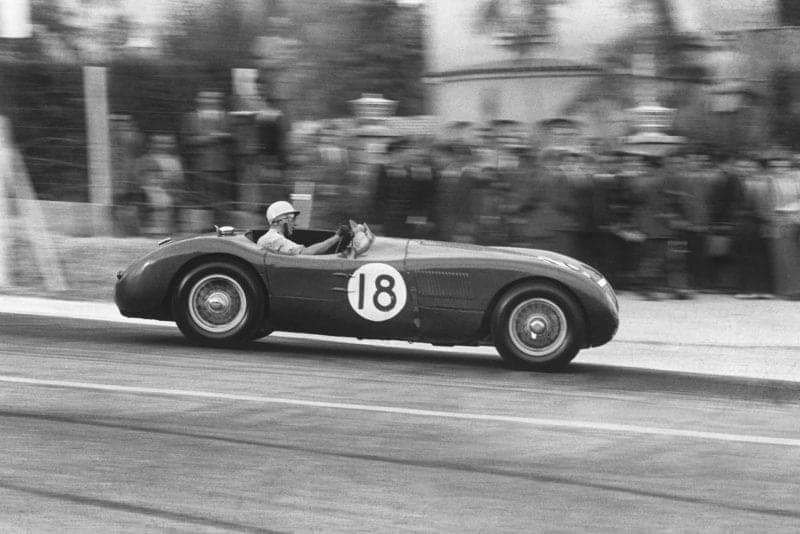
Roy Salvadori en route to second place in the sports car race
Motorsport Images
From then on the 750S Ferrari was unbeatable and though Salvadori tried all he knew he could not make up any ground. Whitehead was a certain third, Sanderson fourth and the rest of the field settled down into a procession, the only drivers that were engaged in a struggle being Graham Whitehead and Nogueira who ran in very close company throughout, victory finally going to the Portuguese driver. Only five laps before the finish the Jaguar engine in Whitehead’s Cooper car made a horrid noise and he came to rest out on the circuit, while a lap later Musy, who had been in eighth place and well up with the bigger cars driving his 2-litre Maserati, also stopped by the wayside.
Picard was quite unchallenged and finished the race comfortably in front of Salvadori and Sanderson, who had moved up through Whitehead’s misfortune. While it was good to see the two Ecurie Ecosse cars in second and third places, it was rather sickening to think that the D-type Jaguar at Earls Court could have been sold to them and they could have won the race with it. As so often happens Great Britain lost the Barcelona Sports Car race due to being six months behind in development and production.
Race
After having their appetites whetted by the Saturday race the Spanish populace turned out in vast numbers for the Grand Prix and the starting grid was a fine example of the healthy state of Grand Prix racing. In the front row, in order of practice times, were Ascari (Lancia), Fangio (Mercédès-Benz), an exposed wheeltype, the streamlined car being abandoned, Hawthorn (Ferrari) and Schell (Maserati), four different makes and four very different designs, all capable of giving the same result; also, the front row drivers were from four different countries, altogether a most satisfactory line up, though Schell’s, time of 2 min. 20.6 sec. was not annnounced in practice. In row two were Villoresi (Lancia), Moss (Maserati) and Musso (Maserati), followed by Trintignant (Ferrari), Herrmann (Mercédès-Benz), Mantovani (Maserati) and Mieres (Maserati), in row four were Kling (Mercédès-Benz), Godia (Maserati) and Wharton (Maserati), while the rest of the slower cars made up the field of 21 starters.

Ascari passed Schell for the lead on lap 3 and began to pull away at a rate of 2 sec per lap
Motorsport Images
Only 3.9 sec. covered the difference in time of the first 10 cars, and as the sun shone down on the starting grid there was a tension in the air and the feeling that this end-of-season race was going to be a hard battle. Ascari, Fangio and Schell got away wheel to wheel with the rest of the 21 cars in hot pursuit and at the end of the opening lap it was the blue and white de Dion Maserati of Schell in the lead, closely followed by Hawthorn, Ascari, Trintignant, Moss, Fangio, Herrmann, Villoresi, Mantovani, Kling, Musso and Mieres, all going by in a continuous string.
It was not until the last five or six cars passed that the field broke formation and hardly had the dust settled before they were all round again, that is all except Villoresi. His Lancia had been driven out to the start some while after the other cars were in place on the grid and appeared to have had some last minute work done on it and on lap two it succumbed and he came into the pits after everyone had passed and retired, the car being driven round the back. Ascari made up for this first retirement by moving up into second place, but still Schell was driving all he knew determined to set the pace. He started the race with a light load of fuel and was out to break up the opposition, but on lap three Ascari passed him and began to draw away.
“In 10 laps both new Lancias had been withdrawn, but at least they had shown remarkable speed up to the point of retiring”
The order settled for a moment, being Ascari, Schell, Hawthorn, Trintignant, Fangio and Moss, the rest beginning to lose ground a little, while after Kling, in 11th position, there was already a long gap before the”also-rans” began to come by headed by Behra in the new Gordini. Ascari began to gain at the rate of 2 sec a lap and on lap nine when he seemed quite settled he suddenly drew into his pit, staying there and talking to his pit-staff before Schell, Hawthorn and Trintignant went by, now in a close bunch. Ascari restarted but only did one lap before stopping for good, the second Lancia also being driven round behind the pits, the reason given at clutch trouble. In 10 laps both new Lancias had been withdrawn, but at least they had shown remarkable speed up to the point of retiring.
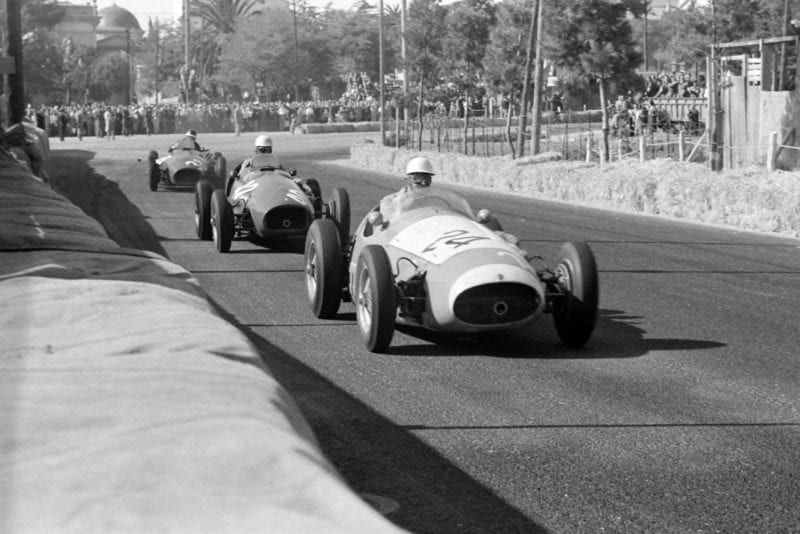
Schell leads after the retirement of Ascari
Motorsport Images
The leading trio were still very close together followed by Moss who had overtaken Fangio, the Mercédès-Benz team being right out of the running, with the other two cars in sixth and tenth position, being Herrmann and Kling respectively. Hawthorn had a slide and lost the other two cars, dropping behind Moss for a moment but he soon got back into third place and began to catch up on Schell and Trintignant again, they still being wheel to wheel. Moss was now slowing and also trailing a tank strap and on lap 10 he pulled into the pit, as it seemed his oil scavenge pump was not working properly and two laps later he retired.
After 20 laps Trintignant was just leading from Schell and Hawthorn and the three of them had left Fangio far behind, and only Herrmann and Musso were keeping up with the Argentinian, all the others dropping a long way back, though the pace was still fast. The leading trio now changed places rapidly, the lead being taken again by Schell, then Hawthorn, then Schell and then the American overdid things and spun, denting the Maserati tail and dropped back to fourth place leaving the two Ferrari drivers only 2 sec. apart and with a lead of 30 sec. over Fangio.
After five more laps Schell appeared going slowly and drew into his pit to retire with a damaged gearbox having had a real go, setting up fastest lap in 2 min 17.8 sec, and showing some of the form he had at the end of the season last year. The event was now only just over a third of the way through, the race being 80 laps in length, and trouble was setting in, for Trintignant stopped with a broken oil feed on his gearbox and lost a lot of time while a repair was made and Hermann’s Mercédès-Benz was not sounding too happy. At the back of the field there was trouble, both Gordinis having been into the pit, Behra to retire with disk-brake trouble, while Wharton had also had stop with the Maserati.
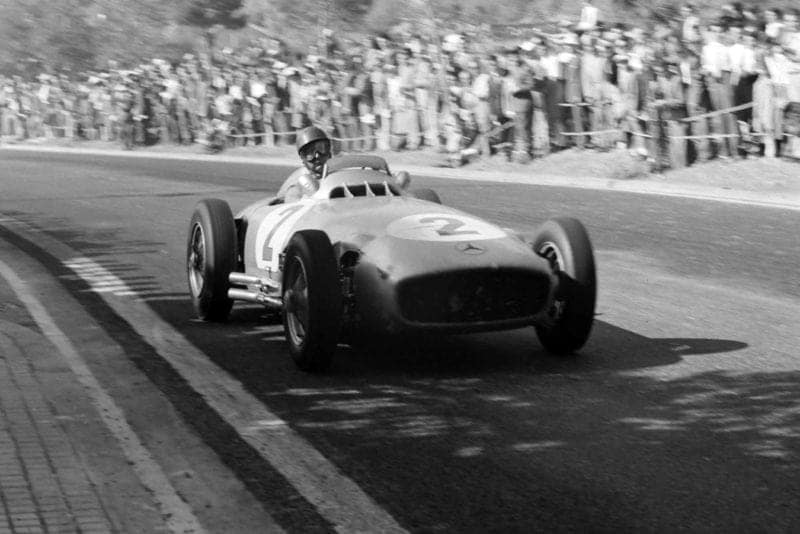
Kling brought his Mercedes home in fifth place
Motorsport Images
Hawthorn was now 23 sec in front of Fangio and it did not look as though the German car had any more speed in hand, while 20 sec farther back came Musso, driving a beautifully steady race and gaining on Fangio. Hermann was going by with his engine popping and banging and he eventually stopped at his pit to talk to Uhlenhaut while the plugs were changed. A new problem was affecting things, for a high wind was blowing down the long straight, carrying clouds of dust and paper and leaves, with the result that drivers goggles were getting covered and the radiator intakes were becoming choked with debris, some of the cars having as-much as 20 per cent. of the opening blanked off by leaves and newspaper, with subsequent overheating.
Herrmann was now only able to keep going by pumping furiously at the hand-circulating pump for the injection system, there obviously being an obstruction in the lines somewhere, while Bira was in trouble with boiling and stopped for water. Musso was driving a very nice race, running a steady third, with his team-mate Mantovani not far behind, but all the time Hawthorn was going round well in the lead, the “stumpy” Ferrari really behaving itself for once and though had slowed occasionally Fangio never get closer than 18 sec, the Argentinian driver’s lap times being a model of consistency in 2 min 24 sec.
“What had started as a furious battle had turned into an endurance race”
Herrmann’s trouble became worse and worse and he eventually retired on the 50th lap, while Trintignant also stopped about this time, the temporary repair being ineffective and all the oil coming out of his gearbox. All this time Kling had been running steadily but without showing any great turn of speed, though as cars ran into trouble he moved up until he was in sixth place, shortly after to go into fifth place, when Mantovani retired. The young Italian had suddenly put on a spurt and caught Musso, only to have his brakes lock on and disappear up an escape road. Though he got going again he stopped two laps later and retired with a damaged rear-end.
What had started as a furious battle had turned into an endurance race with Hawthorn comfortably in the lead, though with a notoriously unreliable type of motor-car, followed 30 sec later by Fangio with a car that had already had a lucky win under similar circumstances. Musso was another 33 sec behind, going very nicely amd a lap later came Mieres and Kling, though a long way apart. Wharton stopped once more, this time for a plug change which did not cure a rough-sounding engine. Bira was still stopping at intervals for water and Rosier was going along, gently. Graffenried had been going round quite well, but now let Volantario drive for him and the car slowed noticeably, finally stopping, while all this let the Spanish driver, Francine Godia into sixth place with the new “un-louvred” Maserati team car.

Moss suffered yet another mechanical issue, going out on lap 20
Motorsport Images
There seemed no hope of anyone changing places and the race settled into a procession until the finish, with the exception of Fangio. With 12 laps to go it became obvious that hot oil was spraying over his left arm and shoulder from somewhere within the car and he began to lose ground to Hawthorn and the next lap the Mercédès-Benz was smoking. A lap later it sounded very rough and began to slow visibly so that Musso gained ground rapidly. Fangio was now suffering badly, the whole of his left side being soaked in hot oil, but drove on as hard as the sick Mercédès-Benz would go, but he could not stop Musso going by into second place only six laps before the finish.
It seemed now that Hawthorn must win, though remembering the Moss epic at Monza no one uncrossed their fingers and in addition it did not seem possible that Fangio could keep going in his bath of oil, nor that the Mercédès-Benz could finish the race losing so much oil. Two laps before the end Hawthorn lapped the unhappy Fangio and only Musso remained on the same lap us the leader. A few minutes after three hours of racing Hawthorn received the chequered flag to win his second major Grand Prix race for Ferrari, but more important to chalk up the first real success for the Type 553 that has given so much trouble all the season. Musso finished a worthy second, having driven a faultless race, looking entirely unruffled throughout, the gallant Fangio limped home third, followed by Mieres and Kling both of whom had driven steady unspectacular races, while the remaining four runners were some way behind.
The Spanish Grand Prix had finished off the 1954 season in a most resounding manner, no one being in a position to say which of the four big teams in Grand Prix racing had the advantege after the first season of the new Formula 1, while there was no doubt that as a Grand Prix formula it has proved a great success. The Spanish race had been satisfying in many ways, for Ferrari went away with renewed life after it disastrous season. Mercédès-Benz were by no means as victorious as expected, but were certainly well in the running, the Maserati team proved once more that their cars are as fast as any, but also showed that reliability was not a strong point, while Lancia must have left with a grin, thinking that at least the long wait to see their cars in action had not been wasted, having dominated the practice periods and the race while the cars lasted. For the private owners and Gordini there was no pleasure, just the realisation that Grand Prix racing was becoming fierce at every meeting and the survival-of-the-fittest was going to be the rule, for starting as well as finishing. D.S.J.
1954 Spanish Grand Prix Race Results
1. Mike Hawthorn (Ferrari) 3:13:52.1
2. Luigi Musso (Maserati) + 1:13.2
3. Juan M. Fangio (Mercédès-Benz) + 1 lap
4. Roberto Mieres (Maserati) + 1 lap
5. Karl Kling (Mercédès-Benz) + 1 lap
6. Paco Godia (Maserati) + 4 laps
7. Louis Rosier (Maserati) + 6 laps
8. Ken Wharton (Maserati) + 6 laps
9. Prince Bira (Maserati) + 12 laps
10. Sergio Mantovani (Maserati) Retired – Brakes
11. Toulo de Graffenried/Ottorino Volonterio (Maserati) Retired – Engine
12. Hans Hermann (Mercedes) Retired – Injection
13. Maurice Trintignant (Ferrari) Retired – Gearbox
14. Jacques Pollet (Gordini) Retired – Engine
15. Harry Schell (Maserati) Retired – Transmission
16. Stirling Moss (Maserati) Retired – Oil Pump
17. Jean Behra (Gordini) Retired – Brakes
18. Jacques Swaters (Ferrari) Retired – Engine
19. Alberto Ascari (Lancia) Retired – Clutch
20. Luigi Villoresi (Lancia) Retired – Brakes
21. Roberto Manzon (Ferrari) Retired – Engine
22. Peter Collins (Vanwall) Did Not Start
Championship Standings
1. Juan Manuel Fangio – 42 (57 1/7)
2. Jose Froilan Gonzalez – 25 1/7 (26 9/14)
3. Mike Hawthorn – 24 9/14
4. Maurice Trintignant – 17
5. Karl Kling – 12
